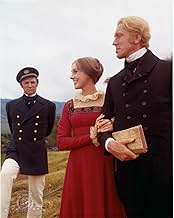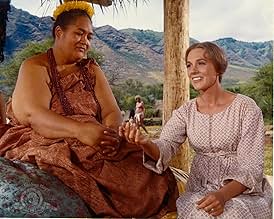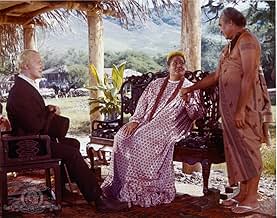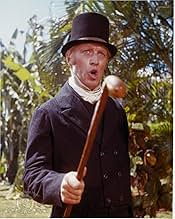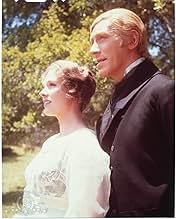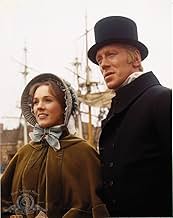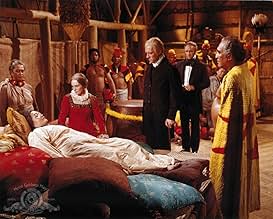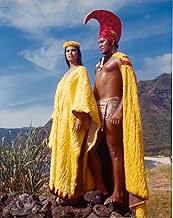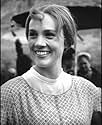Ajouter une intrigue dans votre langueAn American missionary and his wife travel to the exotic island kingdom of Hawaii, intent on converting the natives. But the clash between the two cultures is too great and instead of unders... Tout lireAn American missionary and his wife travel to the exotic island kingdom of Hawaii, intent on converting the natives. But the clash between the two cultures is too great and instead of understanding there comes tragedy.An American missionary and his wife travel to the exotic island kingdom of Hawaii, intent on converting the natives. But the clash between the two cultures is too great and instead of understanding there comes tragedy.
- Réalisation
- Scénario
- Casting principal
- Nommé pour 7 Oscars
- 2 victoires et 10 nominations au total
- Charity Bromley
- (as Diane Sherry)
Avis à la une
Hawaii located where it is between North America and the Orient, when sea travel improved it was only a matter of time before the big powers came a-callin'. And they came from both directions. Not shown in the time frame this film covers, but soon after, waves of Japanese and Chinese immigrants landed on the shore. Hawaii was coveted by all and America got it.
Max Von Sydow plays a young New England minister out to bring the gospel to the heathen as he sees them and has been taught to see them. His church won't send him out to the south seas without a wife, lest he be tempted by sins of the flesh, so on a short acquaintance he marries Julie Andrews. She in turn has been home pining away for whaling captain Richard Harris. When Von Sydow and Andrews get to Hawaii over the course of their story Harris would reappear.
Naturally its quite a culture shock for the New Englanders when they get to Hawaii. The film's story covers about a quarter of a century of Hawaiian history and the history of the changing attitudes of Andrews and Von Sydow.
James Michener's original novel was of War and Peace duration and I suppose the final script was as best they could get it and cover what he was trying to convey. Despite the obvious racist feelings that Von Sydow has, he's a basically decent man who does do some positive good.
His problem is that everything with him has to be filtered through the Bible. There's a lot of incest going on in Hawaii when he lands there. Reason being is that these are islands with a limited number of mating partners. Now incest is bad as we know because it does eventually weaken the gene pool. But Von Sydow hardly takes a scientific approach, how could he, he doesn't know it, he hasn't been taught it.
Julie Andrews is a far cry from the perky Mary Poppins. She develops quite an attachment to Hawaii and its people and her approach with them is fundamentally different than her husband's. It's not a bad performance.
Richard Harris is the lusty whaling captain of Andrews previous affections. I tend to think his part might have been edited down. In a recent biography of Harris, it was stated he and Andrews did not get along at all on the set. Harris in those days was a whole lot like the characters he played like this one in Hawaii.
Of course when you've got Hawaii as a subject for a camera, the photography could not be anything but gorgeous.
Hawaii covers a period not well known to most Americans except Hawaiians. And indeed they are Americans and have been since 1959. I think people could learn something from this film even with the script flaws.
The movie is only about one-fifth of the whole book. Too bad. The movie leaves a lot of unresolved plot threads which are resolved later in the book. Subplots which seem inconsequential turn out to have major implications to the plot of the novel. Minor characters from the movie become more important as the story progresses. For example, Gene Hackman's Dr. John Whipple and Richard Harris' Raefer Hoxworth have only a few scenes in Hawaii, but their characters are perhaps the two most important characters in the book. Whipple and Hoxworth are the ones who challenge the authority of the missionaries and, in a sense, are the true foils to Abner Hale. They also are the ones who go into business.
As a result, the movie, standing by itself, tends to introduce characters and subplots with no relevancy to the main Abner-Jerusha-Malama-Keolo story line. Perhaps a sequel was planned? In short, Hawaii would have worked better as a mini-series.
********************* How the Novel Ends:
Abner Hale's son, Micah, who was last seen getting a boat to the mainland to attend Yale University, becomes a minister like his father. The sea captain, Raefer Hoxworth, marries Noelini, the daughter of the Alii Nui. Micah then meets and falls in love with Raefer's and Noelini's daughter. They get married. Abner Hale scorns Micha; claiming the Micah has gone "whoring with the heathens." Micah quits the ministry and becomes a partner in Raefer Hoxworth's shipping company - now called Hoxworth and Hale.
John Whipple and Retire Janders (the captain of the ship that brought the missionaries to Hawaii) are partners in Janders & Whipple. Initially a trading company, general store, and ship chandler, they start acquiring land and growing sugar. J&W eventually becomes a plantation company and needs cheap labor to work their fields. John Whipple imports Chinese workers.
A generation after the movie ends, the descendants of Hale, Whipple, Janders, Hewlett (the man who was kicked out of the church for marrying a Hawaiian woman) and the Hoxworth are the commercial, social, and political elite of Hawaii. Micah Hale leads the movement to have the United States annex Hawaii and serves as the first governor of the Territory of Hawaii.
The descendants of these families continue to build their businsses and develop the islands. In an ironic twist, the families, refusing to marry Hawaiians or Chinese, intermarry. Eventually cousins marry cousins - the very practices Abner Hale condemned from his puplit. You eventually get characters named: Whipple Hoxworth; Hoxworth Hale; Hewlett Janders; Bromley Hoxworth.
Finally, at the end of the novel the rich, post-WW II descendants of the missionaries talk about their "distinguished ancestors." Their descriptions and interpretation of events, differs from what it portrayed in the earlier chapters.
Gene Hackman in early role
Directors George Roy Hill Arthur Hiller(temporarily replaced director) Writers James A. Michener(novel) Dalton Trumbo(screenplay) Daniel Taradash(screenplay) Stars Julie Andrews Max von Sydow Richard Harris Julie Andrews and Jocelyne LaGarde in Hawaii (1966)
Two cultures collide in this vast, lavish and truly spectacular film Adapted from James A. Michener's Pulitzer Prize-winning novel and nominated* for seven Oscars, this "majestic, gorgeously climatic epic with adventuresome picture-making, a credit to the industry"; and riveting entertainment! They came to bring God, but instead brought disease and destruction. The Rev. Abner Hale (Von Sydow) and his gentle wife Jerusha (Andrews) attempt to convert early 19th-century Hawaiian natives to Christianity but find themselves ill-equipped to endure the unexpected tribulations of paradise. Surging with the excitement of windstorms, firestorms, shark attacks and magnificent island scenery, Hawaii shines as passionately as the island paradise itself!
Julie Andrews and Max von Sydow in Hawaii (1966)
1966: It received seven nominations at the 39th Academy Awards: Best Supporting Actress (Nominated- Jocelyne LaGarde), Best Cinematography- Color (Nominated), Best Costume Design-Color (Nominated), Best Sound (Nominated), Best Effects- Visual Effects (Nominated), Best Music-Original Song (Nominated), Best Music-Original Music Score (Nominated) I think this film is worth seeking out ! It is on blu-ray/DVD.and multiple streaming /Tubi, Prime 7.8/10 Great Movie Poster!
Even if you hate aspects of history, it doesn't matter. This motion picture is great theater. Humanity is put on display by gifted actors under gifted direction. The script strikes home because it is so spare and poetic.
It is a pity that of the cast members, Jocelyn LaGarde, who is the perfect alii nui--Queen of the Hawaiians--gets such a skimpy bio. Under her name, all we get is that she'd been six feet in height. What a natural actress! What an open smile! What powerful yet benign reality!
Julie Andrews and Max von Sydow stay deep in their characters. The tragedy of cultures' colliding never ends. On a personal level, we get that eternal conflict again, between the classically female value of compassion and the male value of standards--you know...you must earn your father's love.
What is special must be preserved. Nationhood must live. There is much grist for thought in this sweeping drama.
Le saviez-vous
- AnecdotesJocelyne LaGarde is the only performer in Academy Award history to be nominated for her only screen role. LaGarde had never acted before, and never acted again in her entire life.
- GaffesWhen Jerusha is in labor Abner times her contractions very closely with his pocket watch. Most pocket watches in the 1820's had no second hands, particularly one owned by a poor missionary.
- Citations
Dr. John Whipple: [Addressing Abner, while holding Keoki's lifeless body, victim of the measles epidemic that has ravaged the native Hawaiians] There's nothing you could've done for him... When Captain Cook discovered these islands 50 years ago, they were a true paradise. Infectious disease was unknown. They didn't even catch cold! And there were 400,000 of them - now there are less than 150,000. You and I may well live to see the last Hawaiian lowered into his grave - with proper Christian services, of course.
- Versions alternativesOriginal version ran 189 minutes; subsequently cut to 171 minutes. The general release version ran 151 minutes. Full-length version available on home video.
- ConnexionsFeatured in The Dick Cavett Show: Julie Andrews/Blake Edwards (1971)
Meilleurs choix
Détails
- Date de sortie
- Pays d’origine
- Langues
- Aussi connu sous le nom de
- Hawaii
- Lieux de tournage
- Bodo, Norvège(Missionary boat saing thru Magellan Straits)
- Sociétés de production
- Voir plus de crédits d'entreprise sur IMDbPro
Box-office
- Budget
- 15 000 000 $US (estimé)
- Durée
- 3h 9min(189 min)
- Couleur
- Rapport de forme
- 2.35 : 1


